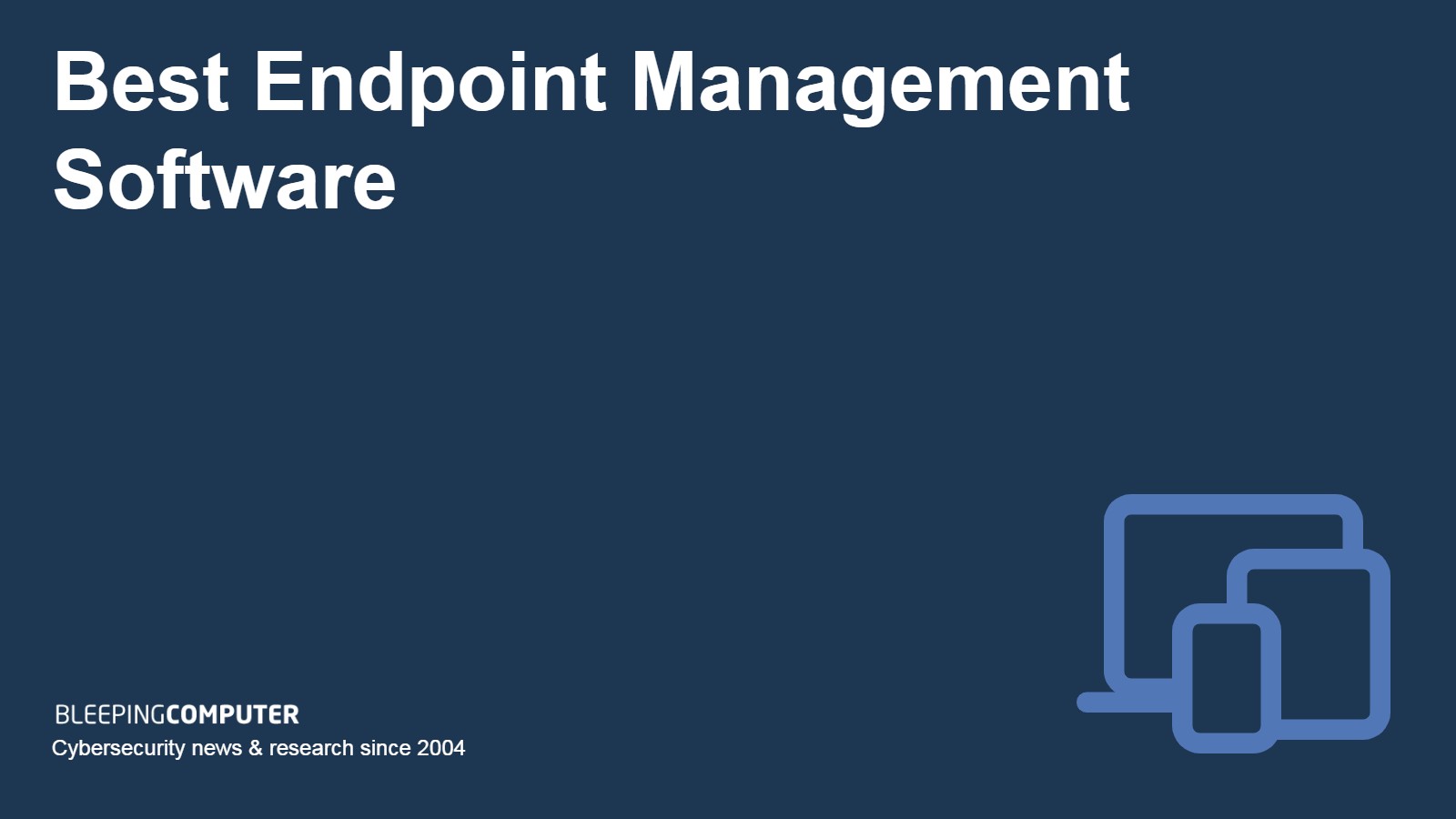
The modern workplace is filled with all sorts of gadgets: laptops, desktops, tablets, and smartphones. Each one needs to be kept secure, updated, and managed properly, but dealing with all these devices can be really stressful.
To make things easier for you, we've compiled a list of the top eight Endpoint Management Software (EMS) solutions. Whether you run a small business or a large corporation, this guide will help you find the right tool to effectively manage your endpoints.
Here is our list of the best endpoint management software:
- NinjaOne - EDITOR'S CHOICE: This cloud-based tool provides a combination of endpoint management features and constant system monitoring services that reduce the need for expensive technical staff in an IT operations team or a managed service provider. Security tools include automated patching. You can register for a 14-day free trial.
- Microsoft Intune: Intune is a cloud-based service that allows businesses to manage devices and applications from a single console. Intune is a part of the Microsoft Endpoint Management family. A 90-day free trial is available.
- CrowdStrike Falcon: CrowdStrike Falcon is an award-winning endpoint management platform that combines security and IT functions to safeguard against all major risks, and comes with a free 15-day trial.
- VMware Workspace One: Workspace ONE integrates flexible and adaptive endpoint management, intelligent insights and automation, digital workspace security, and device-aware access policies into a single platform.
- Ivanti Endpoint Manager: Endpoint Manager stands out for its ability to manage complex IT environments, robust security features, and automation capabilities. It is ideal for MSPs and large enterprises.
- Hexnode: Hexnode offers a robust solution for efficiently managing and securing devices across platforms and locations. Well-suited for a variety of organizations looking for a feature-rich endpoint management solution.
- ManageEngine Endpoint Central: Endpoint Central is the ideal solution for organizations seeking to streamline device management, improve IT staff efficiency, and enhance endpoint security.
- Atera: Atera caters to MSPs seeking to streamline service delivery and improve profitability, as well as internal IT teams within organizations.
The best endpoint management software
Methodology used for our selection
In selecting our EMS solution providers, a combination of factors were considered to provide a well-rounded list. Some criteria include:
- Feature set: Each option offers a comprehensive range of features important for endpoint management, including device management, application management, security tools, and patch management. Some go even further with functionalities like AI integration or mobile-specific features.
- Target audience: The list includes options suited for businesses of all sizes, from enterprise-grade solutions like Microsoft Endpoint Manager (MEM) to cost-effective options for smaller businesses like ManageEngine Endpoint Central. There are also options tailored for Managed Service Providers (MSPs) like Atera.
- Popularity and market presence: These are all well-established players in the endpoint management software market, with a proven track record and large user base.
- Positive reviews and reputation: These are generally well-regarded endpoint management solutions with positive user reviews and industry recognition.
However, it's important to note that the "best" endpoint management software ultimately depends on your specific needs. When making your choice, you need to consider factors such as your company size and needs, security goals, existing IT infrastructure, and budget. By considering these factors and researching the options provided below, you can find the endpoint management software that best suits your specific requirements.
1. NinjaOne (FREE TRIAL)
NinjaOne is designed to simplify IT tasks and improve overall endpoint security. It operates by installing agents onto the endpoint devices in your IT setup. These agents allow you to monitor, support, and control any internet-connected endpoints. With NinjaOne, you can oversee and manage all your endpoints from one place, ensuring you don't overlook any important alerts.
Key features:
- Monitoring and alerting: Real-time device monitoring with automatic alerts to quickly address issues and minimize impact on users.
- Secure remote access: Securely access managed endpoints for efficient support.
- Patch management: Automated patching for various operating systems and applications, with a dashboard for easy patching oversight.
- Endpoint task automation: Automate repetitive tasks to standardize outcomes, save technician time, and enhance device stability.
- Auto-remediation: Automatically detect and resolve endpoint issues using condition-based script deployments.
Why do we recommend it?
We recommend NinjaOne because it offers a compelling combination of features that streamline IT operations, bolster security posture, and adapt to your specific needs. I found it to be a powerful and user-friendly solution that provides enhanced visibility and control over your endpoints and empowers IT teams to manage their endpoint device effectively.
Who is it recommended for?
NinjaOne is ideal for SMBs, MSPs, organizations with geographically dispersed devices, and others looking to streamline IT management and improve security. Organizations with geographically dispersed devices find NinjaOne invaluable for remote monitoring and management, particularly useful for remote workers or multiple branch offices. Its robust automation capabilities make it suitable for organizations focusing on efficiency.
Pros:
- Multi-tenant architecture: This allows MSPs and IT operations teams to efficiently manage devices for multiple clients from a single platform.
- Intelligent issue resolution: Automated remediation capabilities minimizes reliance on manual intervention and frees up IT staff for more complex tasks.
- Comprehensive software management: This simplifies software deployment, updates, and uninstalls, saving time and effort for IT teams.
- Flexible reporting and customization: NinjaOne provides granular control over device reporting. This ensures you get the information you need in a format that best suits your requirements.
- Scalability for growth: Its ability to handle large numbers of devices ensures it can adapt to your growing IT infrastructure.
Cons:
- Limited transparency on pricing: The lack of a publicly available price list can be inconvenient and make it difficult to compare costs with other solutions upfront.
You can request a quote and you can register for a 14-day free trial.
EDITOR’S CHOICE
NinjaOne is our top pick for an endpoint management software to protect your network because this package implements continuous monitoring of endpoints and network devices and will also ensure that all endpoints are kept secure in order to block threats. The monitoring feature in the NinjaOne package operates continuously without human intervention. One of its tasks is to scan endpoints for out-of-date software, which provides a way in for malware and intruders. The package automatically fetches patches and applies them to shut down those discovered vulnerabilities. The system will raise alerts if traffic surges occur, so technicians get a quick early warning of flood attacks, such as DDoS. This package is suitable for use by IT operations teams and can monitor multiple sites within one account. NinjaOne has a multi-tenant account structure, which makes it suitable for managed service providers.
Get a 14-day free trial: https://www.ninjaone.com/freetrialform/
Operating system: Cloud-based
2. Microsoft Intune
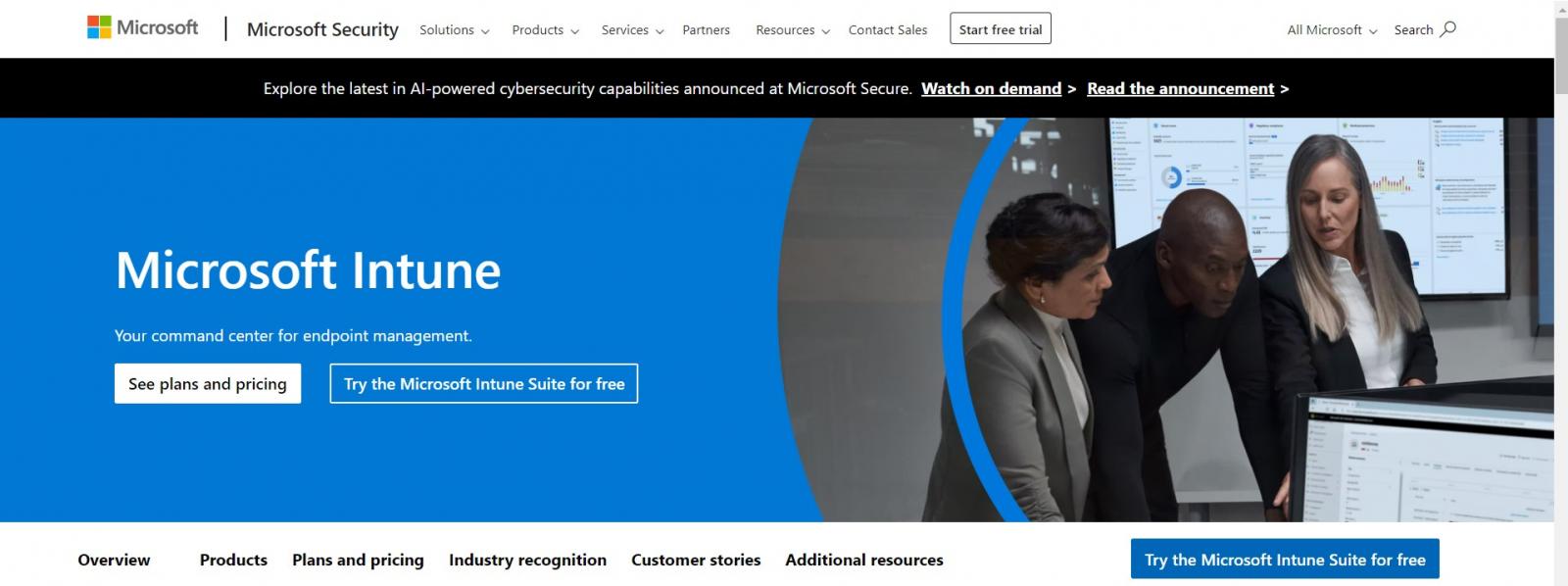
Microsoft Intune is a cloud-based unified endpoint management solution for both corporate and BYOD devices. It manages user access to organizational resources and simplifies app and device management across multiple operating systems, cloud, on-premises, mobile, desktop, and virtualized endpoints.
The Microsoft Intune family of products and services includes Microsoft Intune service, Configuration Manager and co-management, Endpoint Analytics, Windows Autopilot, and Intune admin center.
Key features:
- Advanced endpoint management and security: Offers advanced features for endpoint management and security, including optional add-ons like Remote Help, Endpoint Privilege Management, and Microsoft Tunnel for MAM.
- Device management: Allows you to manage both organization-owned and personally owned devices across various platforms.
- App management: Intune simplifies app management with built-in features for app deployment, updates, and removal.
- Web-based admin center: Administrators can manage endpoint devices and access data-driven reporting through a web-based admin center.
- Integration with security services: It integrates with mobile threat defense services such as Microsoft Defender for Endpoint, allowing for real-time threat analysis, automated remediation, and enhanced endpoint security.
Why do we recommend it?
We recommend Microsoft Intune for its comprehensive suite of features that address advanced endpoint management and security needs.
I observed that its device management functionality allows organizations to manage both organization-owned and personally owned devices across various platforms, ensuring comprehensive coverage; while its policy automation and self-service capabilities empower users and reduce support overhead.
Who is it recommended for?
Microsoft Intune is perfect for organizations heavily invested in the Microsoft ecosystem as it offers unified user experience, streamlined management, improved security, and usability.
If your organization primarily uses Microsoft cloud and Windows devices, Intune offers a familiar and potentially cost-effective solution. For IT staff already comfortable with Microsoft products, Intune's interface can minimize training time and ensure a smoother adoption process.
A 90-day free trial is available.
Pros:
- Cross-platform support: Intune supports a wide range of platforms including Android, iOS/iPadOS, Linux, macOS, and Windows, making it versatile for managing diverse device environments within organizations.
- Policy automation: Intune automates the deployment of policies for apps, security, compliance, and device configurations, enabling administrators to enforce consistent standards efficiently.
- Self-service capabilities: Employees and students can utilize self-service features within the Company Portal app, empowering them to perform tasks such as password resets and app installations independently, reducing support overhead.
Cons:
- Focus on Windows devices: While it can manage other OS platforms to some extent, its functionality might not be as comprehensive for non-Windows systems.
3. CrowdStrike Falcon
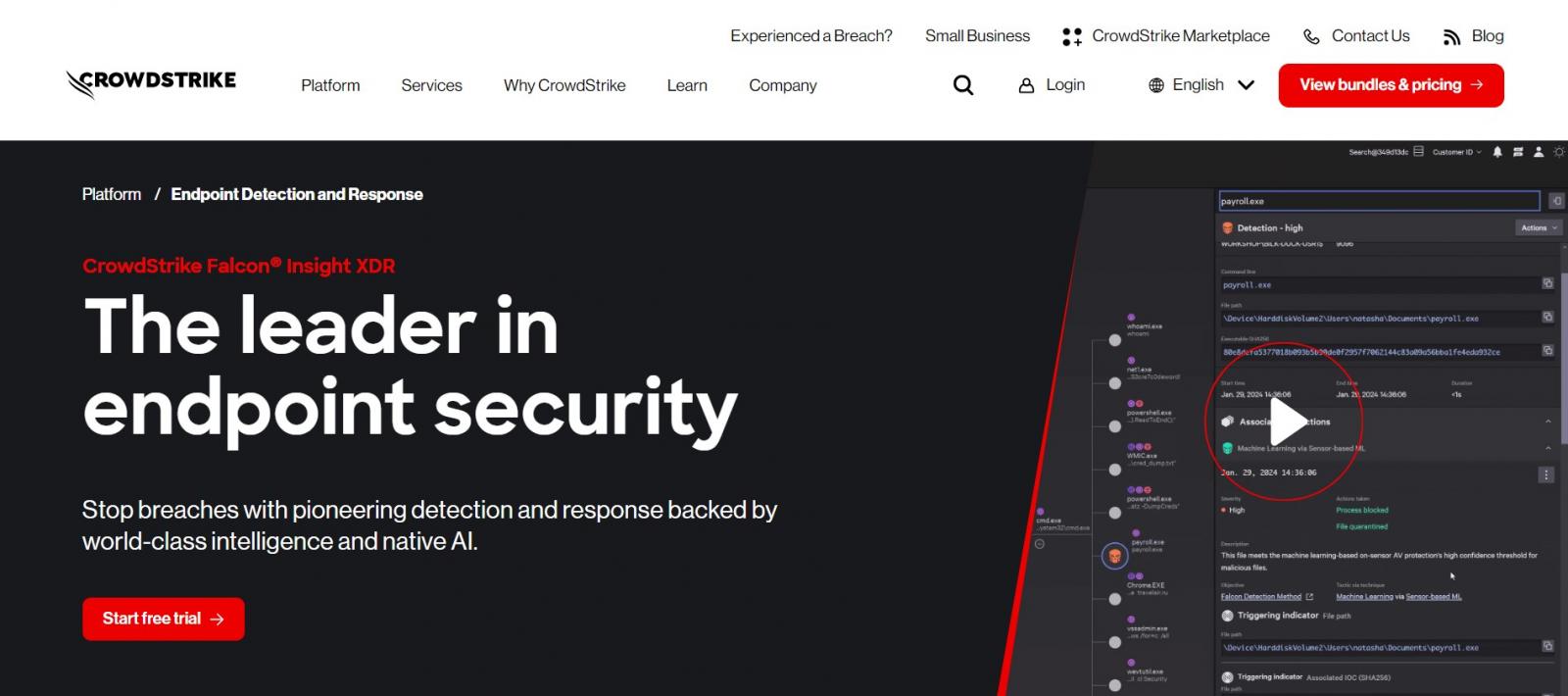
CrowdStrike Falcon is an award-winning endpoint management platform that combines security and IT functions to safeguard against all major risks. It's simple to set up using just one lightweight agent that is cloud-managed and delivered. After setup, you can manage your security from one central console. CrowdStrike was named a leader in the 2023 Gartner® Magic Quadrant™ for Endpoint Protection Platforms.
Key features:
- Cloud-native architecture: Crowdstrike Falcon cloud-native architecture allows it to operate independently of operating systems or hardware-defined network perimeters.
- Single platform, console, and agent: The Falcon platform integrates security and IT functions to protect all areas of risk, allowing for centralized management from a unified console.
- Open and extensible ecosystem: Falcon supports an open and extensible ecosystem, enabling the addition of more platform modules using the same lightweight sensor from the original deployment.
- Automated threat intelligence: Falcon defeats adversaries with automated threat intelligence, leveraging advanced algorithms and real-time data analysis to identify and respond to threats effectively.
Why do we recommend it?
We recommend CrowdStrike for its innovative approach to modern enterprise security. CrowdStrike offers a single agent solution designed to protect against breaches, ransomware, and cyberattacks, backed by world-class security expertise and deep industry experience. I discovered that by leveraging AI-powered technology, CrowdStrike provides instant visibility into potential threats, enabling proactive defense strategies.
Who is it recommended for?
CrowdStrike is a great option for the modern workplace and organizations that need a security-focused endpoint management solution. These organizations typically have more complex IT environments with a greater number of endpoints that require robust security solutions.
Comes with a free 15-day trial.
Pros:
- Comprehensive protection: Falcon offers total protection against a wide range of threats, including malware, ransomware, and cyberattacks.
- Centralized management: The platform provides centralized management through a unified console, simplifying deployment and administration tasks for IT teams.
- AI-powered security: Its AI-driven threat intelligence and detection allows it to deliver advanced security capabilities, enhancing threat detection and response effectiveness.
- Ease of deployment: Falcon's lightweight agent and cloud-native architecture facilitate easy deployment across diverse environments, reducing deployment time and operational overhead.
Cons:
- Dependency on cloud infrastructure: As a cloud-native solution, Falcon's effectiveness may be impacted by internet connectivity and reliance on cloud infrastructure, posing challenges in environments with limited internet access.
4. VMware Workspace ONE
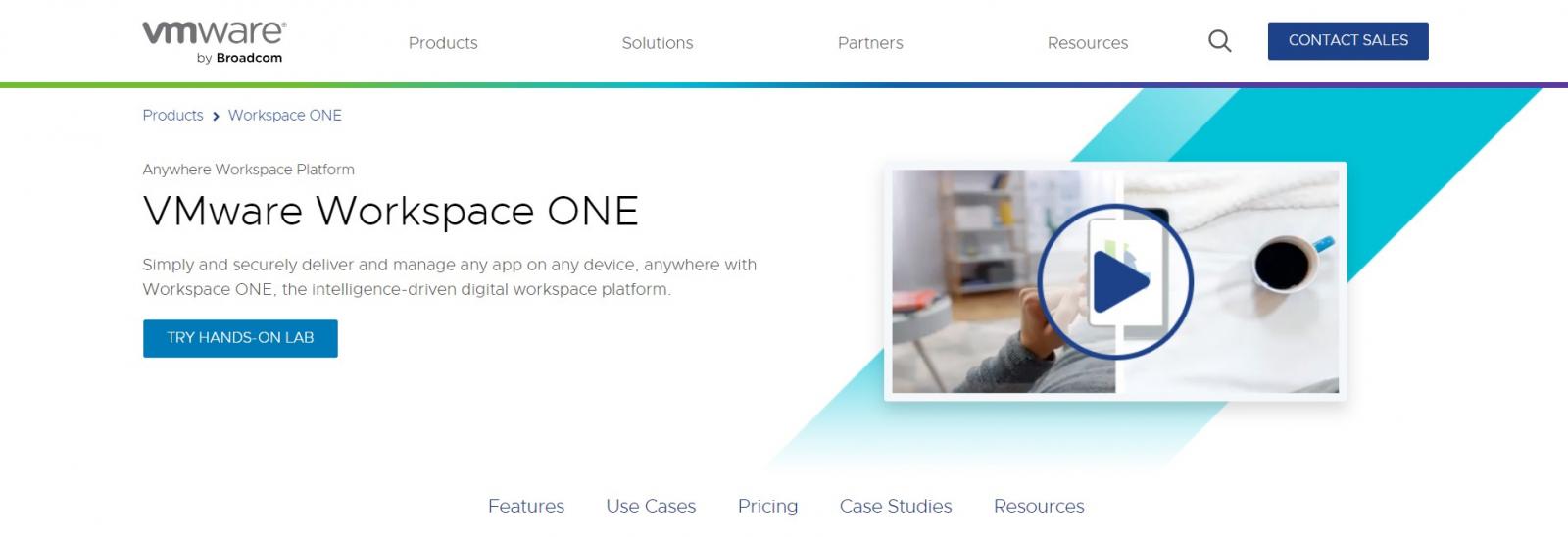
Workspace ONE is a digital workspace platform from VMware that provides UEM capabilities. It allows businesses to manage a wide range of devices, including laptops, desktops, smartphones, and tablets. Workspace ONE is a great option for businesses that need a solution that can manage a variety of device types.
Key features:
- Unified security: Offers unified security across users, devices, applications, and work locations, with automated and responsive security measures.
- Industry-leading UEM: Consolidates device and app management silos, reducing costs with a UEM solution.
- Self-service workspace: Delivers apps, notifications, and self-service resources to any user or device through a centralized enterprise catalog.
- Rich insights & analytics: Leverages an AI/ML-powered data science engine to aggregate, correlate, and visualize data across the digital workspace.
Why do we recommend it?
We recommend VMware Workspace ONE for its robust and user-centric UEM solution. It integrates flexible and adaptive endpoint management, intelligent insights and automation, digital workspace security, and device-aware access policies into a single platform. I noted that VMware Workspace ONE stands out for its comprehensive features, exceptional user experience, and efficiency in managing endpoints, making it an ideal choice for organizations seeking a best-in-class UEM solution.
Who is it recommended for?
VMware Workspace ONE is ideal for organizations with complex IT environments, a focus on robust security, and the need to manage a diverse range of devices. Its zero-trust security approach and ability to securely manage and access devices remotely makes it suitable for organizations with employees working from home, branch offices, or on the go.
Offers a free trial.
Pros:
- Intelligent insights and automation: Utilizes intelligent insights and automation to streamline IT tasks, enhance operational efficiency, and improve decision-making processes.
- Digital workspace security: Ensures comprehensive security for the digital workspace, safeguarding against threats and vulnerabilities across devices, applications, and data.
- Device-aware access policies: Implements device-aware access policies to enforce security measures based on device characteristics, enhancing access control and data protection.
- Digital employee experience: Enhances the digital employee experience by providing a user-friendly and productive environment, empowering employees to work efficiently and securely from any location.
Cons:
- Dependency on automation: Reliance on automation processes may pose challenges if automation encounters errors or limitations.
5. Ivanti Endpoint Manager
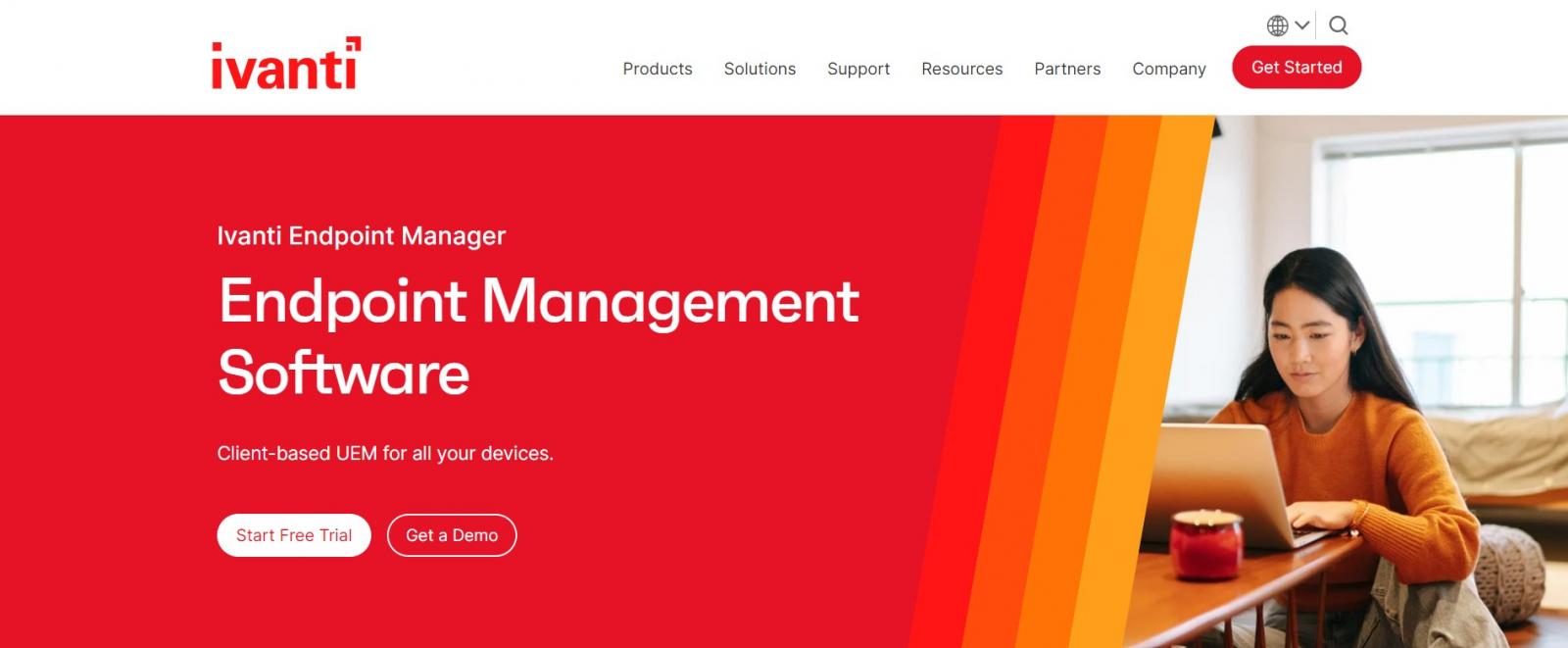
Ivanti Endpoint Manager is an all-in-one solution for managing user profiles and client devices across various operating systems, including Windows, macOS, Linux, Chrome OS, and IoT devices. It provides centralized management capabilities, allowing administrators to oversee all endpoints from a single platform.
Key features:
- Remote control: Easily access and control PCs or Macs from anywhere, enabling IT administrators to analyze systems, resolve issues, and minimize desk-side visits.
- Application provisioning: Provide applications to users seamlessly, ensuring they have access to the software they need to perform their duties effectively.
- User profile management: Facilitate easy movement of users and their profiles between machines, ensuring fast logon times and seamless user experiences.
- Dashboards and reporting: Generate visual dashboards integrating business and IT data without the need for coding or BI expertise.
- Add-ons: Additional features include MDM for managing and securing mobile devices, Cloud-based UEM for centralized device management, and Digital Employee Experience Management for tracking and optimizing employee digital experiences.
Why do we recommend it?
Ivanti Endpoint Manager distinguishes itself through its comprehensive and innovative approach to endpoint management. It stands out for its ability to manage complex IT environments, robust security features, and automation capabilities. I determined that it's a strong contender for large enterprises and MSPs. This is why we recommend it.
Who is it recommended for?
Ivanti Endpoint Manager is ideal for large enterprises and MSPs. If you manage a vast network of desktops, laptops, servers, and mobile devices across various locations, Ivanti Endpoint Manager excels at handling such complexity.
A free trial is available on request.
Pros:
- Dashboards and reporting: Generates visual dashboards integrating business and IT data without the need for coding or BI expertise.
- Integration and automation: Ivanti integrates with various systems and automates tasks such as patching and security threat remediation, enhancing operational efficiency.
- User-friendly interface: The platform provides an intuitive interface with dashboards and reporting tools, making it easy for administrators to monitor and manage endpoints effectively.
Cons:
- Overkill for simple needs: Ivanti Endpoint Manager's robust feature set might be overkill for very small businesses with simple device management needs.
6. Hexnode UEM

Hexnode UEM is a cloud-based UEM solution that offers a wide range of features, including mobile device management (MDM), mobile application management (MAM), and endpoint security. Hexnode UEM is a great option for businesses that require a flexible and scalable solution.
Key features:
- Security management: Offers an intelligent security suite with granular management capabilities over device security, including data loss prevention (DLP) policies and threat management based on a zero-trust approach.
- Website kiosk lockdown: Locks down corporate Android and iOS devices into website kiosks, allowing them to be converted into self-service kiosks restricted to a single website or a set of predefined websites/web apps.
- User provisioning: Simplifies user enrollment and device setup, offering employees a quick and seamless way to enroll their devices and gain secure access to corporate resources.
- Geofencing: Defines policy zones and exclusion zones based on geographical locations.
- Remote control: Allows remote access to devices for instant issue debugging and resolution over-the-air, whether deployed in the field or in self-service installations.
Why do we recommend it?
We recommend Hexnode UEM for its comprehensive features and capabilities that cater to the diverse needs of businesses. With zero-touch deployment, remote assistance and support, endpoint management, intelligent automation, and enterprise-ready integrations, Hexnode offers a robust solution for efficiently managing and securing devices across platforms and locations. I noticed that Hexnode UEM was recognized in the 2023 Gartner® Market Guide for UEM tools.
Who is it recommended for?
Hexnode UEM is well-suited for a variety of organizations looking for a user-friendly and feature-rich endpoint management solution, particularly MSPs, SMBs, large enterprises, organizations with mixed IT environments, and those value automation and extensive security features.
A free 14-day trial is available on request.
Pros:
- Enhanced security: Provides robust security measures, including DLP policies and multi-level threat monitoring, to mitigate inadvertent data loss and ensure device integrity and compliance.
- Multi platform support: Provides support for a wide range of platforms, including Apple, Android, Mac, Windows, Apple TV, Android TV, and Fire OS. This broad platform coverage allows organizations to manage diverse device environments efficiently.
- Enterprise integrations: Integrates with various enterprise systems and services, thereby enabling organizations to leverage existing infrastructure and streamline device management processes effectively.
Cons:
- Learning curve: Due to the extensive feature set, there may be a learning curve for administrators unfamiliar with the platform, requiring initial training and familiarization.
7. ManageEngine Endpoint Central
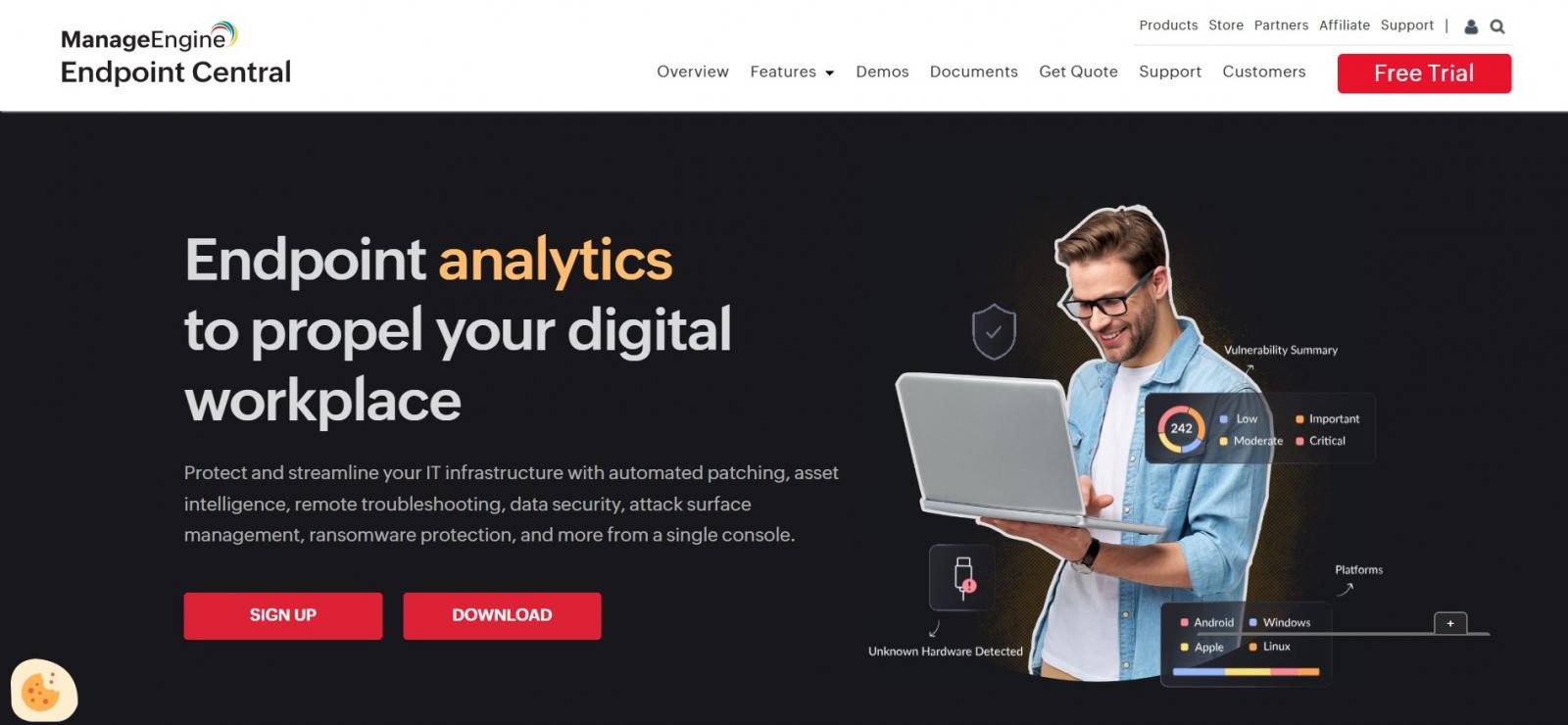
ManageEngine Endpoint Central is a UEM solution designed to help organizations manage and secure desktops, laptops, servers, and mobile devices from a single platform. It caters to businesses of various sizes, with a focus on streamlining IT administration tasks and improving endpoint security.
Key features:
- Next-Gen antivirus: Utilize robust, patented technology to proactively detect, prevent, and mitigate malware threats, ensuring comprehensive endpoint security.
- Vulnerability and patch management: Secure and stabilize OS, applications, and mobile apps with automated patches and updates, minimizing vulnerabilities and enhancing system integrity.
- Endpoint analytics: Gain insights into endpoint experience by analyzing application and device performance data, enabling informed decision-making and optimization.
- Configuration management: Centralize and manage user-based and computer-based configurations to improve operational efficiency and ensure consistency across endpoints.
- Asset management: Discover, track, and control all hardware, software, and digital assets with live notifications and predefined inventory reports, facilitating effective asset management.
Why do we recommend it?
We recommend ManageEngine Endpoint Central for its user-friendliness, strong automation capabilities, cost-effective pricing, and balanced feature set that caters to the core UEM needs of businesses of various sizes. I learned that the ability to manage multiple device types, including mobile devices, and its integration capabilities further enhance its appeal.
Who is it recommended for?
ManageEngine Endpoint Central caters to a broad audience, from internal IT teams in businesses of various sizes to Managed Service Providers. Its focus on user-friendliness, automation, scalability, cost-effectiveness, and core UEM functionalities makes it a compelling solution for organizations seeking to streamline device management, improve IT staff efficiency, and enhance endpoint security.
A free 30-day trial is available on request.
Pros:
- Comprehensive security features: Offers a range of security features, including next-gen antivirus, patch management, and vulnerability remediation, ensuring robust protection against threats.
- Insightful analytics: Provide valuable insights into application and device performance, enabling proactive optimization and troubleshooting.
- Centralized management: This simplifies administration and ensures consistency across endpoints, enhancing overall governance and control.
Cons:
- Learning curve: Implementing and configuring ManageEngine Endpoint Central may require a learning curve and significant setup time, particularly for organizations new to the platform.
8. Atera
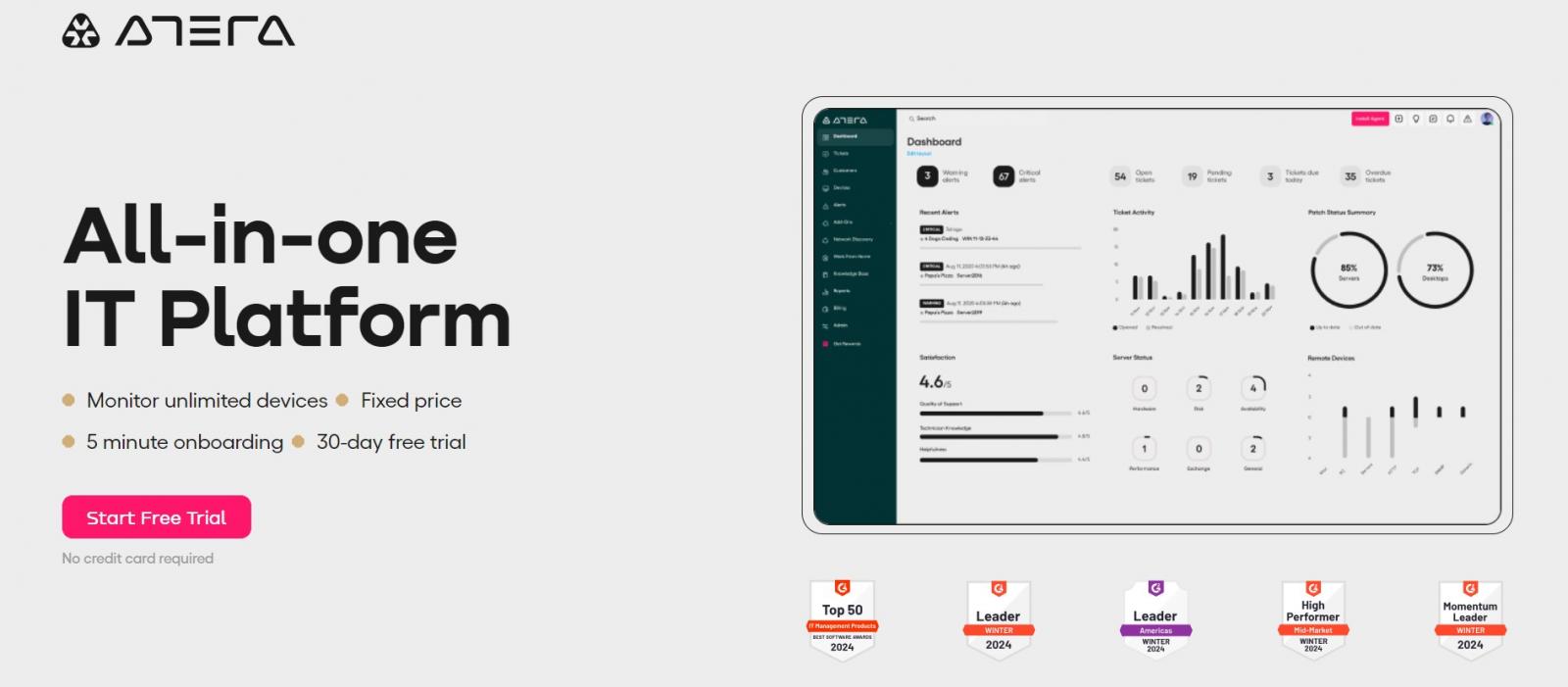
Atera is a cloud-based Remote Monitoring and Management (RMM) platform designed for IT professionals and MSPs. It essentially functions as an all-in-one toolbox for managing, monitoring, securing, and troubleshooting various endpoint devices within a centralized location.
Key features:
- Remote monitoring and management (RMM): Atera offers all-in-one RMM software that provides full visibility and control, allowing IT management to shift from reactive to proactive approaches with a single solution.
- Professional services automation (PSA): Simplify tasks and communication with intuitive helpdesk, billing, and reporting features.
- AI capabilities: Atera incorporates AI technology, offering extraordinary capabilities to enhance IT management processes.
- Remote access: Easily start remote sessions directly from alerts, tickets, or devices using supported platforms such as AnyDesk, Splashtop, TeamViewer, or ScreenConnect.
- Patch management: Automate patching for Windows, Mac, and other software and operating systems on end-users' devices to ensure they remain up-to-date and secure.
- Network discovery: Provides comprehensive security scans and complete views of end-user networks and devices, automatically updating to maintain an accurate picture.
Why do we recommend it?
Atera stands out for its user-friendly interface, robust automation, cost-effective pay-per-technician model, and built-in features that streamline workflows for both MSPs and internal IT teams.
I found that with Atera's RMM and PSA features, IT automation is integrated into daily operations, enabling MSPs to support more customers while freeing up time for strategic value-added activities. Atera's solution not only simplifies the work-life of IT teams but also allows them to provide better service to users and optimize their operational efficiency.
Who is it recommended for?
Atera caters to MSPs seeking to streamline service delivery and improve profitability, as well as internal IT teams within organizations of various sizes that require efficient endpoint management, improved IT staff efficiency, and enhanced security. The user-friendly interface, scalability, and focus on automation make Atera a compelling solution for these target markets.
A free 30-day trial is available on request.
Pros:
- Comprehensive solution: Atera offers a comprehensive solution for IT management, combining RMM, PSA, AI capabilities, remote access, patch management, network discovery, and integrations in a single platform.
- Simplicity and ease of use: Atera's intuitive interface simplifies tasks and communication, making it easy for IT professionals to manage their environments effectively.
- Integrations: Atera allows for seamless integration with familiar tools and software add-ons, enabling IT environments to evolve and adapt to changing needs.
Cons:
- Limited MDM features: Atera offers basic functionalities for managing mobile devices. MSPs or IT teams working with clients who heavily rely on mobile devices and prioritize robust mobile security might find Atera's features inadequate.
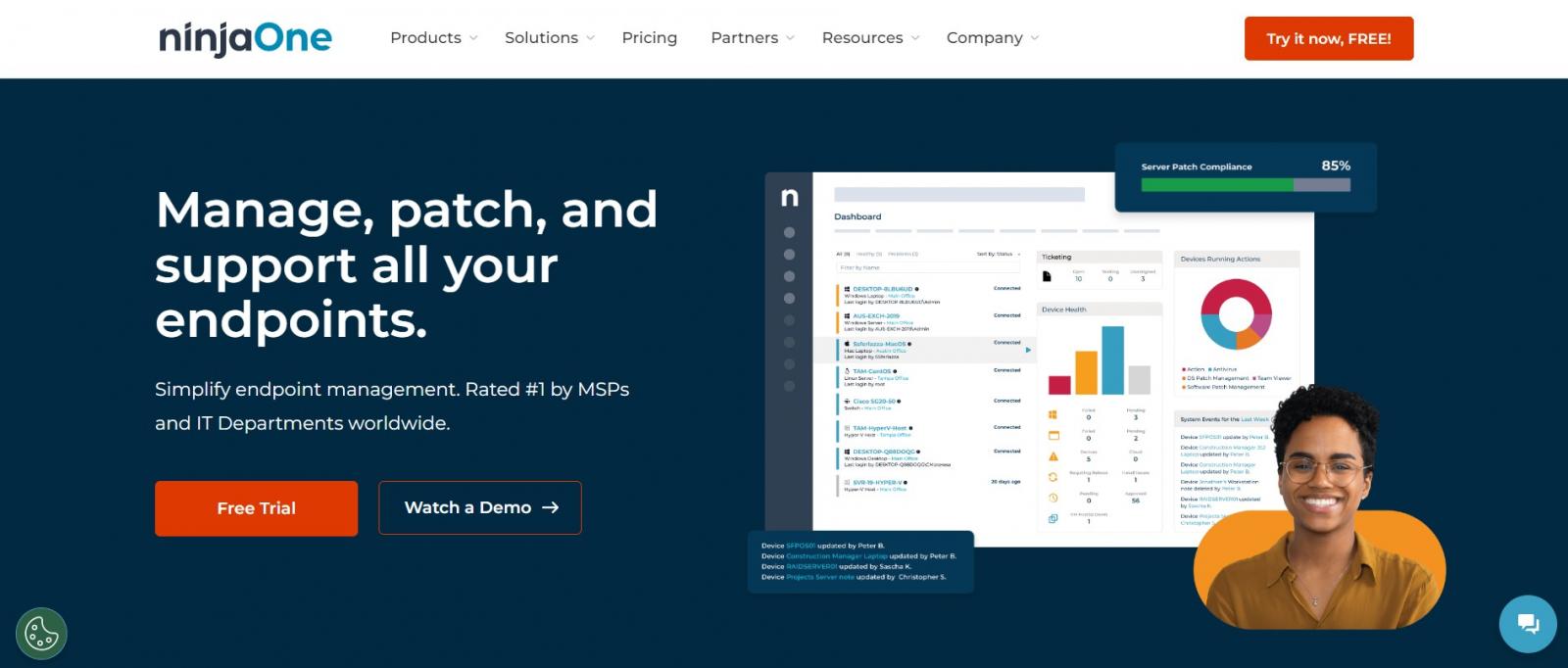


Post a Comment Community Rules
You need to login in order to post a comment
Not a member yet? Register Now